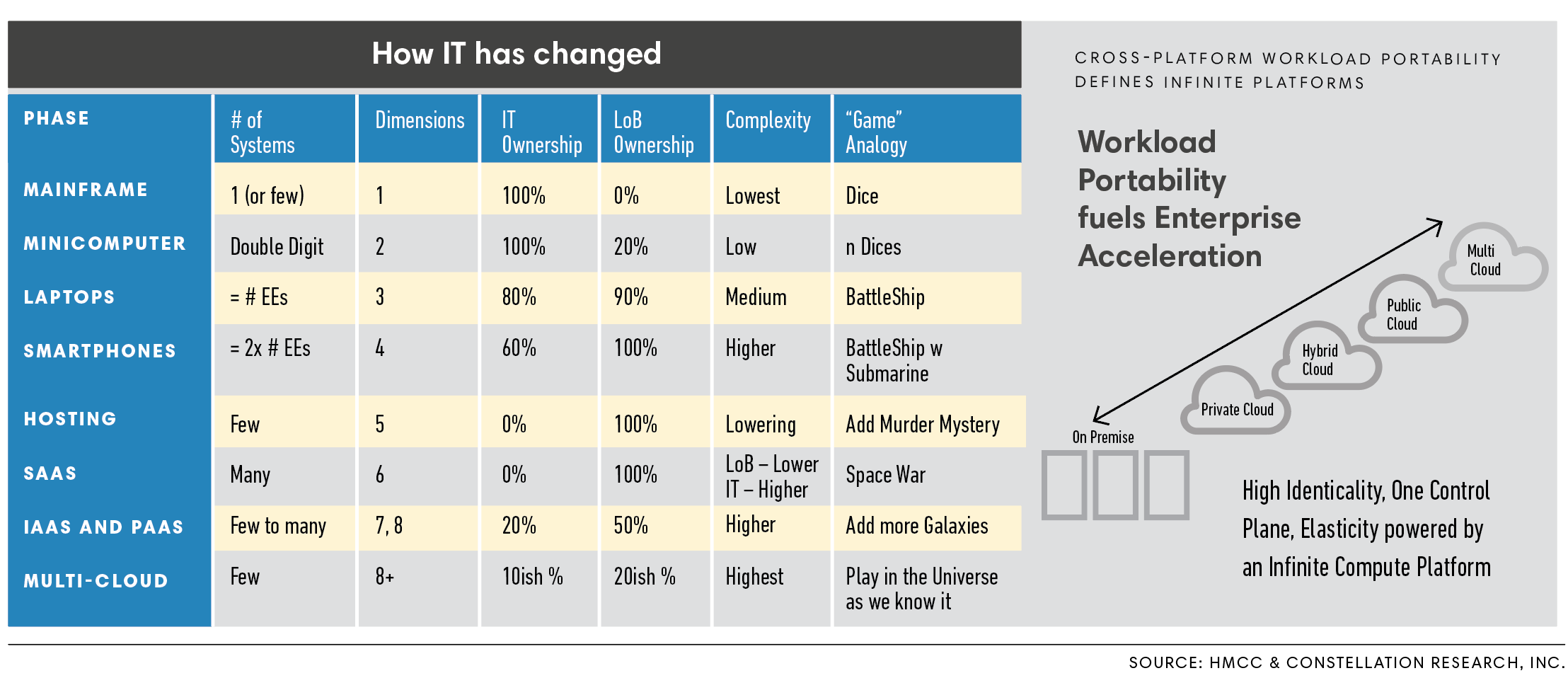There is no question anymore that technology progress has overtaken the technology demands of business best practices, creating the current need for experimentation and exploration of how to operate a business in the 21st century. The main drivers of the technology progress have been the increase of complexity and the leverage of economies of cloud vendors and their platforms. But is this all good for the future of the enterprise?
Let’s see how we got here, what the cloud is and how to survive best in these tumultuous times.
How did we get here?
The IT landscape gets more and more complex for enterprises year after year. Gone are the days when an enterprise could say – all our applications run on our mainframe. Let’s look at the transformation of IT in the last 70 years:
• The beginning: the mainframe era. It all began in the 1950s, life seemed challenging but was easy compared to today – there was literally one of the few systems where IT happened. In an example of how IT does not discard technologies, mainframes are alive and well in 2021.
• The first erosion: medium data range minicomputers. Enterprises needed more local IT capacity and more flexibility, most prominently DEC and Wang responded, and IT fragmentation happened rather quickly, but central control was still ruling.
• The laptop revolution. The need for workforce empowerment and productivity led to the desktop and then the laptop, eroding on-premise control by IT and opening the door to tremendous security challenges.
• The smartphone reality. Starting out as ‘dumb’ telephones, smartphones came in overnight, and while once leader Blackberry kept IT in charge, the following iPhone rise put the user/consumer in charge, fragmenting IT even further.
• Hosting has its charm. Struggling with complexity, enterprises soon found out that service providers were willing to ‘run their mess for less’, using economies of scale. The approach never became mainstream.
• SaaS vendors appear – and the cloud journey begins. The first SaaS vendors wrestled away the control of owning the business automation an enterprise would run. Originally welcome, as innovation of on-premise vendors was lacking, enterprises still struggle today with the SaaS innovation cycles.
• IaaS and PaaS enters IT making hybrid cloud real. More recently, the ‘as a Service’ concept has been applied to infrastructure and platforms, giving enterprises both technological and commercial choice in abundance, but also making IT management a multi-dimensional game to master.
• Cloud by accident or design makes multi-cloud real. SaaS gave businesses a ticket to freedom from IT, and with that making decisions about platforms and outsourcing their management. Cloud happened ‘by accident’ from an IT perspective and the whole trend led us to where we are today where multi-cloud is real for almost all enterprises.
In summary, first IT, then the business lost control over their business automation, first on the platform side, mostly by IT, often cheered on by the LoB due to frustrations with the IT function, then on the software side for both functions, as they transitioned from ownership to renting of software. No doubt there are tremendous potential upsides of relinquishing control on the software side, like faster innovation cycles, more modern platforms, and user experiences, but enterprises get lumped together in the ‘herd’ of subscription users. That in itself has a whole set of pros and cons… which we may highlight in another piece here.

But let’s understand ‘cloud’ first
The term cloud has been re-defined and abused ad absurdum, so let’s understand what deployment options enterprises have for their workloads:
• On-premise. Enterprises still need to be able to operate their workloads on-premise. The most prominent drivers are data residency requirements, performance requirements and a lack of local public cloud data centres, often all coupled with a substantial dose of public cloud skepticism. But on-premise always means ownership of hardware and usually processes.
• Private cloud. When operating workloads on-premise, it is wise for enterprises to be able to use some of the cloud’s benefits, most notably elasticity. Being able to scale workloads on demand using cloud technologies in an elastic way is the reason for operating private clouds. Recently vendors have innovated with subscription-based hardware and services – so the enterprise does not have to own anymore all aspects of operating a hybrid cloud.
• Hybrid cloud. A combination between on-premise/private cloud and public cloud creates the hybrid cloud operational scenario, which is the reality for most enterprises today, as they operate on-premise and in the cloud, maybe through some SaaS decisions that have been taken. Ownership is mixed between on-premise (enterprise) and cloud (respective vendors), but the integration is ultimately owned by the enterprise.
• Public cloud. The public cloud with its ‘pure’ cloud characteristics, most prominently elasticity, is a key operational platform, especially for new workloads coming from next-generation applications. The ownership of enterprises is reduced to mostly decisions about which clouds to use and then how to implement them in the confines of the options provided by the cloud vendor.
• Multi-cloud. Automation split across multiple public clouds creates the multi-cloud scenario that most enterprises find themselves in, mostly due to SaaS vendors’ public cloud choices. Enterprise ownership is similar to the public cloud scenario, only that complexity is increased.
There are inherent risks operating in this environment, here we name the most prominent ones:
• Complexity can kill. Complexity can lead to higher cost and a loss of enterprise agility, leading to lower or even no enterprise acceleration.
• Lock-in can hurt. IT history is full of situations where vendors turned the thumbscrews on enterprises, so they want to avoid lock-in.
• Vendor dependency can be bad. A great vendor today may not be a great vendor tomorrow, so enterprises want to preserve the ability to shift their workloads to tomorrow’s great vendor.
• Scarcity of talent creates operational risks. People remain essential to enterprise success, but it will become even more challenging to recruit and retain great talent – and operational complexity needs more talent that is excellent in regards to managing the underlying platforms.
The solution: infinite computing platforms
The only way for enterprises to protect themselves from potential bad outcomes in this complex operating environment, is to look for the portability of their workloads, across the different forms of cloud, including on-premise.
At Constellation we call these platforms ‘infinite computing platforms’, as they allow an enterprise to operate in a non-limited, therefore infinite, way across the platforms on which it wants to operate its enterprise automation workloads.
The definition of an infinite computing platform is as follows, the criteria below being the most dominant ones:
• Supports at least two cloud deployment forms.
• Managed as a SaaS platform by the vendor.
• Operates with a single pane of glass across platforms.
The good news is these infinite computing platforms are emerging fast and all over the enterprise stack. Here are some of the players across the enterprise stack that enable infinite computing:
• Two-dimensional players – My cloud and on-premise: AWS with Outposts, Google Cloud with Anthos (but see also below), IBM with Satellite, Microsoft with Azure Stack and Azure Arc, Oracle with Oracle Cloud at Customer/Dedicated Region.
• Multi-dimensional players – My cloud, my competitor cloud and on-premise: Google with Anthos and BigQuery Omni, IBM with OpenShift
• Virtualisation players – Your VM – anywhere: Nutanix and VMware.
• PaaS players – This PaaS capability – anywhere. CloudFoundry (PaaS), HashiCorp with Cloud Platform (Cloud and DevOps), Mirantis Container Cloud (containers), MongoDB Atlas (database), SAP BTP (PaaS)
As with any nascent software category, innovation is fast and furious, and the vendors are juggling for their respective space in the market. CxOs need to determine which vendor gives their enterprise the best benefits that they can reap from an infinite computing platform.

The takeaways
While software and IT are more important for the success of an enterprise, the operational challenges are also bigger than ever, and so are the risks of operating on legacy, dwindling (or worst dying) platforms. While much of the complexity results from the transition of automation assets from on-premise to the cloud, CxOs know deep inside that the future is multi-cloud and that is an inherently more complex environment than operating all of the IT landscape on-premise. On the bright side, vendor offerings are emerging, and that presents the workload portability that enterprises need and want to succeed in the 2020s. In closing, CxOs will be aware that they are trading off dependency on many platforms and vendors, to fewer platforms and vendors, thus increasing dependency, but reducing net complexity. Sometimes I used to wish a CxO from 2021 could speak to the VP of electricity from the early 1900s… and see the historic VP’s shock when he discovers the nonchalant attitude to not create electricity on site, relying on a single utility company to power the enterprise.
In reality though, practically all enterprises operate – in a multicloud world, using all cloud providers, and there is a high chance an enterprise with 5,000 people or more are present on all three clouds.
Understanding the key concepts
By now you have a good understanding of cloud and its inner workings. But what about the other key technology concepts – here is a short rundown:
• Infinite computing. If you cannot count something, it may as well be infinite. Even better if you can pay for it as your busines scales up and down. The end of finite computing that relies on sized machines in your data centre is the start of the Infinite Computing era. Its five layers are already familiar (Infinite Communications aka – the internet), used by disruptive enterprises (Infinite Insights – Hadoop style technologies), more widely used (Infinite Compute – from the cloud), the innovation layer (Infinite AI/ML – look at Tensorflow) and the frontier, almost not used yet (Infinite Deep Learning). Adoption of the Infinite Compute technologies is key for enterprise survival.
• Next generation applications. As Infinite Computing becomes reality, technology capability overtakes best practice demands. Effectively, new best practices are being enabled and created. CxOs cannot afford to wait for their standard software vendors to provide these, as standard software vendors want to run the same software for hundreds if not thousands of customers. The result is that enterprises need to build software again and build their own next generation applications. The seven generic use cases for next generation applications are: digitising value chains; tame the internet for demand chain usage; revolutionise intra-enterprise functions for the value chain and across the three chains to build IoT applications; enable Data-as-a-Service (DaaS); re-invent communication (Zoom anyone); and innovate the human-machine interface.
• Enterprise acceleration. Enterprises need to move faster and become more agile. To win they need to advance their people skills, improve their people processes and provide modern platforms for their enterprise to Excel. The speed of an enterprise needs to exceed the speed demands of the markets it wants to successfully compete in… and the speed is determined by the potential and ability of its people as well as the technology platform. The inherent speed of the technology platforms determines the limitation to enterprise velocity, therefore technology and software matter so much for enterprise success in the 21st century.
Holger Mueller, VP and principal analyst, Constellation Research





